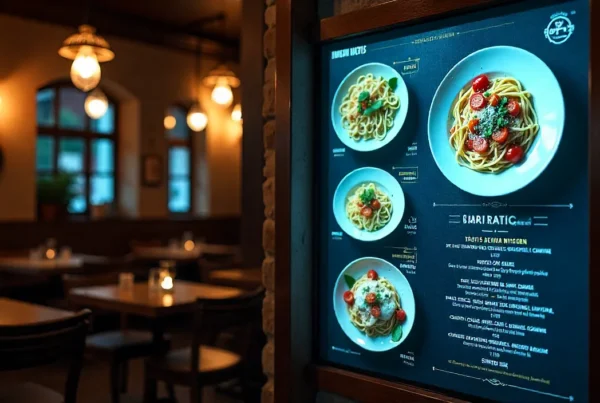Using a self hosted digital signage system to manage displays provides complete control over content, security, and infrastructure without the regular cloud charges. You may be looking for an open-source digital signage system to display in a school, a digital signage local server to display in a corporate lobby, or a low-cost digital signage system to display in a retail store—this guide can take you through software, advantages, and implementation.

What Is Self Hosted Digital Signage?
Self hosted digital signage means that you are using your signage CMS on your own servers, whether on premises or in a private cloud, rather than using third-party cloud providers. This method allows you to control the security policies, operate offline, and not pay monthly fees as found in cloud-based digital signage software. Self-hosting is perfect in sensitive environments (e.g., a healthcare facility or finance) or areas with intermittent internet connectivity where you want your network of screens to be independent and secure.
Key Features of Self Hosted Digital Signage Software
Local Server Deployment
Install your digital signage software on any hardware you already have, a rack server in your data center, or a basic digital signage TV software player, such as a Raspberry Pi. When you have digital signage CMS installed locally, content pushes occur on your LAN, guaranteeing lightning-fast updates and zero reliance on the outside internet.
Complete Content Control
Self-hosting means you own 100 percent of all assets: images, videos, HTML widgets, and emergency alerts. No vendor downtime or black box hosting, no possibility of your digital signage software solutions going down due to vendor problems.
Offline Functionality
You do not have to worry about your internet connection going down, as a self hosted digital signage installation continues to operate. Promotions, wayfinding, and important messages do not stop as scheduling and media are cached locally on the CMS on your digital signage local server.
Customization & Scalability
Open-source systems such as Xibo and Screenly OSE are customizable to any degree. Require a custom integration with your ERP to live displays of inventory? Or a shift changes custom scheduling rule? Self-hosting allows you to change code, install plugins, or horizontally scale by launching more server instances.
Low-Cost Operation
Self hosted digital signage software is either open source or has a one-off license cost, which removes the subscription fees. When used together with low-cost hardware solutions, such as mini PCs, Chromeboxes, or low-cost digital signage players, you will experience a much lower cost of ownership in the long run.
Why Choose Self Hosted over Cloud-Based?
Whereas the cloud-based digital signage software is easy to implement and can be accessed remotely, self-hosting is the best when you want:
• Improved Security: The data is on your network, and access to it is controlled by your IT policies.
• Offline Resilience: Displays continue displaying content even in the absence of the internet.
• No Vendor Lock-In: You can switch or upgrade open-source platforms without contractual limitation.
• Cost Savings: Eliminate monthly per-screen costs that are characteristic of digital signage software systems.

Top Self Hosted Digital Signage Solutions
Screenly OSE (Open Source Edition)
Screenly OSE is an operating system based on Raspberry Pi that provides an experience of lightweight digital signage programs. It has a web-based interface that supports playlists, multi-zone layouts, and offline caching, and it does not charge subscription fees.
Xibo
Xibo is a powerful digital signage CMS that works with Windows, Linux, and Android players. It is a go-to-date product in enterprises that require full control in terms of its scheduling engine, interactive content modules, and role-based administration.
Concerto
Concerto is designed to be simple and provides web-based content submission and RSS integration. It is perfect in situations where an organization requires a simple, open-source digital signage system that has role-based access.
Nento (Self-Hosted Option)
Nento is mainly a cloud-based solution, but it also offers on-premises deployment to those who need a self hosted digital signage solution. It is user-friendly as it has a drag-and-drop editor, remote management, and support for HDMI sticks.
PiSignage
PiSignage is cost-effective content management software for digital signage that integrates cheap digital signage hardware support (Raspberry Pi) and advanced capabilities such as API integration, scheduling dynamic content, and managing multiple screens.
How to Set Up Self Hosted Digital Signage
1. Choose Your Software
Compare capabilities, open source or licensed operating systems needed, scheduling, etc., and choose a platform (e.g., Xibo, Screenly OSE).
2. Select Hardware
• Raspberry Pi: Cheap digital signage, power saving, ideal basic signage.
• Mini PCs/NUCs: More power to video-intensive or interactive screens.
• Commercial Displays: A few of them have built-in media players that work with your CMS.

3. Install & Configure
Install the CMS on your local server or directly on the device of the player. Set up your network, user roles, and preferred playlists.
4. Connect Displays and Test
Hook up screens, check content playback, and test offline fallback by simulating a network outage.
5. Maintain & Update
Make it a habit to update software, check the health of the servers, and clear out the obsolete media.
Self Hosted vs. Cloud-Based at a Glance
| Feature | Self Hosted | Cloud‑Based |
| Internet Dependency | Offline capable | Requires constant connection |
| Cost | One‑time/license fee | Ongoing subscription fees |
| Customization | Fully customizable | Limited by vendor capabilities |
| Security | Your network, your policies | One-time/license fee |
| Maintenance | Vendor-controlled security | Handled by provider |
Self Hosted Digital Signage: Take Control
Self hosted digital signage gives you complete control over your displays, helps keep your data private, and saves you money in the long run. You can select a lightweight open source such as Screenly OSE, a full-featured CMS such as Xibo, or a hybrid local/cloud such as Nento, but when you self-host, the flexibility is unparalleled.
Want to implement your own digital signage? Start by reviewing your content requirements, infrastructure, and security needs, and make the first step towards a Self Hosted network that demonstrates your brand’s desire to be innovative and reliable.
FAQs About Self Hosted Digital Signage
Can I use a Raspberry Pi for Self Hosted digital signage?
Yes—projects such as Screenly OSE and PiSignage are tailored to the Raspberry Pi and provide a cost-effective entry point to Self Hosted digital signage.
What’s the best open-source digital signage software?
Xibo and Screenly OSE are the frontrunners, with their active communities, large feature sets, and multiplatformdeployments.
How secure is a Self Hosted digital signage local server?
Security is based on your network configuration and IT policies. Hosting on your LAN prevents external intrusions, but you have to implement typical server hardening, a firewall, and access controls.
Is self-hosting cheaper than cloud-based signage?
In most cases, yes—through the removal of per-screen monthly fees. But include the cost of the hardware and in-house IT labor.
How do I update content on a Self Hosted system?
You access the CMS web interface, which is like a cloud system, to schedule, upload, and manage media on a remote basis across your LAN.
Do I need coding skills to implement Self Hosted digital signage?
A lot of solutions provide user-friendly dashboards. Nevertheless, open-source platforms might involve technical configuration. To have turnkey ease, paid licenses or managed Self Hosted such as Nento may be considered.
Can Self Hosted signage integrate with other systems?
Definitely, most of them provide APIs and POS, ERP, social media, and data feeds, and they allow dynamic, data-driven content.





